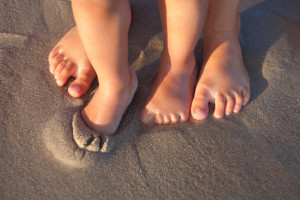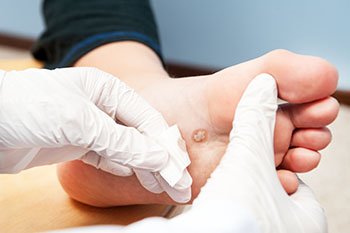Items filtered by date: February 2023
Do You Suffer From Painful Feet?
Why Are My Child’s Feet Peeling?

If a child’s feet are peeling, it is usually from something benign, such as dry skin, athlete’s foot, or another type of skin condition. Skin typically regenerates itself and at the end of the cycle, dead skin sloughs off. This happens naturally when the feet are washed regularly and if this does not happen, the flaking and peeling will be noticeable. Peeling can also result from dehydration, dry air, or a related type of skin damage. For example, if the feet get sunburnt or blisters develop, the skin will eventually peel. Athlete’s foot and eczema can be other reasons for peeling skin, and they can cause inflammation, itching, and scaling. There are other serious reasons for peeling skin, so if your child’s feet are peeling and you are not aware of the cause, it is wise to seek counsel from a podiatrist who can evaluate the condition and provide appropriate treatment.
The health of a child’s feet is vital to their overall well-being. If you have any questions regarding foot health, contact Charles Perry, DPM of Ohio. Our doctor can provide the care you need to keep you pain-free and on your feet.
Tips for Keeping Children's Feet Healthy
- Make sure their shoes fit properly
- Look for any signs of in-toeing or out-toeing
- Check to see if they have Clubfoot (condition that affects your child’s foot and ankle, twisting the heel and toes inward) which is one of the most common nonmajor birth defects.
- Lightly cover your baby’s feet (Tight covers may keep your baby from moving their feet freely, and could prevent normal development)
- Allow your toddler to go shoeless (Shoes can be restricting for a young child’s foot)
- Cut toenails straight across to avoid ingrown toenails
- Keep your child’s foot clean and dry
- Cover cuts and scrapes. Wash any scratches with soap and water and cover them with a bandage until they’ve healed.
If you have any questions, please feel free to contact our offices located in Cambridge and Zanesville, OH . We offer the newest diagnostic and treatment technologies for all your foot care needs.
A Grocery List for Gout

Many individuals who are familiar with arthritis might already know what gout is in the feet. Essentially, gout is a particular kind of arthritis that is characterized by flare-ups in the big toe joint. If you are living with gout, there are certain food items you might consider purchasing or abstaining from during your weekly trip to the grocery store. This is because certain foods and items can either calm or exacerbate your gout. For example, when you are strolling through the grocery, you might consider stopping by the vegetable aisle to pick up different healthy veggies. While you are in the dairy aisle, you might select items like skim milk or other low-fat dairy products, like yogurt. Additionally, when shopping, you could think about passing by the red meat aisle, as red meat can sometimes exacerbate gout. You could also consider passing up alcoholic beverages. Contact a podiatrist today for more information about treating your gout.
Gout is a foot condition that requires certain treatment and care. If you are seeking treatment, contact Charles Perry, DPM from Ohio. Our doctor will treat your foot and ankle needs.
What Is Gout?
Gout is a type of arthritis caused by a buildup of uric acid in the bloodstream. It often develops in the foot, especially the big toe area, although it can manifest in other parts of the body as well. Gout can make walking and standing very painful and is especially common in diabetics and the obese.
People typically get gout because of a poor diet. Genetic predisposition is also a factor. The children of parents who have had gout frequently have a chance of developing it themselves.
Gout can easily be identified by redness and inflammation of the big toe and the surrounding areas of the foot. Other symptoms include extreme fatigue, joint pain, and running high fevers. Sometimes corticosteroid drugs can be prescribed to treat gout, but the best way to combat this disease is to get more exercise and eat a better diet.
If you have any questions please feel free to contact our offices located in Cambridge and Zanesville, OH . We offer the newest diagnostic and treatment technologies for all your foot and ankle needs.
Plantar Warts in Public Pools

Plantar warts are affected areas of the skin on the bottom, or soles, of the feet. Importantly, the plantar warts are spread by the human papillomavirus. There are certain areas and environments in which the spread of this virus is more likely or expected. For example, public swimming pools are a primary breeding ground for the development of plantar warts. This is because many people are often walking around the sides of pools without any shoes. Also, this virus thrives in moist, warm environments. There are several things that you might consider doing to protect your feet from developing plantar warts if you regularly frequent public pools. Most importantly, you might consider simply wearing flip flops or some form of foot protection when walking around the pool. This protects the feet from making contact with any substances that can lead to the development of plantar warts. Contact a podiatrist today for more information.
Plantar warts can be very uncomfortable. If you need your feet checked, contact Charles Perry, DPM from Ohio. Our doctor will assist you with all of your foot and ankle needs.
About Plantar Warts
Plantar warts are the result of HPV, or human papillomavirus, getting into open wounds on the feet. They are mostly found on the heels or balls of the feet.
While plantar warts are generally harmless, those experiencing excessive pain or those suffering from diabetes or a compromised immune system require immediate medical care. Plantar warts are easily diagnosed, usually through scraping off a bit of rough skin or by getting a biopsy.
Symptoms
- Lesions on the bottom of your feet, usually rough and grainy
- Hard or thick callused spots
- Wart seeds, which are small clotted blood vessels that look like little black spots
- Pain, discomfort, or tenderness of your feet when walking or standing
Treatment
- Freezing
- Electric tool removal
- Laser Treatment
- Topical Creams (prescription only)
- Over-the-counter medications
To help prevent developing plantar warts, avoid walking barefoot over abrasive surfaces that can cause cuts or wounds for HPV to get into. Avoiding direct contact with other warts, as well as not picking or rubbing existing warts, can help prevent the further spread of plantar warts. However, if you think you have developed plantar warts, speak to your podiatrist. He or she can diagnose the warts on your feet and recommend the appropriate treatment options.
If you have any questions please feel free to contact our offices located in Cambridge and Zanesville, OH . We offer the newest diagnostic and treatment technologies for all your foot and ankle needs.

